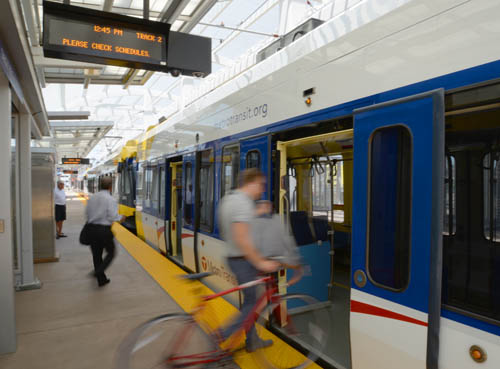Project timeline shows 2019 opening
2015: The Federal Transit Administration issues its Record of Decision and approves the project to enter the engineering phase of the New Starts process. The project will submit request to enter final design.
2016: Secure Full Funding Grant Agreement, committing the federal government to pay 50% of the project’s capital cost.
2016 – 2018: Heavy construction.
2019: Southwest LRT begins passenger service as part of the Green Line.
A new chapter is beginning for the METRO Green Line Extension (Southwest Light Rail transit project), following approval from all the cities on the line, including Minneapolis.
The Southwest Project Office will hire a peer review consultant in September to review the work of staff engineers and consulting engineers. The office also will publish a Request for Proposals for the advanced design contract to be awarded in late 2014. And the Southwest Project Office will submit a New Starts application later in September to the Federal Transit Administration (FTA) to advance the project.
Supplemental draft environmental impact statement expected in early 2015
In early 2015, the federal government will publish the Supplemental Draft Environmental Impact Statement. Public hearings and a 45-day public comment period will follow. The SDEIS will identify any new potential impacts caused by the Southwest LRT Project and possible actions to reduce or mitigate these new potential impacts.
Anyone, including cities and the public, will have an opportunity to comment on the SDEIS. If, as a result of those comments, substantial changes need to be made to the physical design components of the preliminary design plan, the Metropolitan Council would have to seek further municipal consent as appropriate under state statute. The Final EIS is to be published later in 2015, addressing comments on the SDEIS.
 The project has received $705 million in local funding commitments to date out of $827 million needed locally for the $1.65 billion total project budget. This includes full commitments from the Counties Transit Improvement Board and the Hennepin County Regional Railroad Authority, as well as $44 million of the state’s 10% share.
The project has received $705 million in local funding commitments to date out of $827 million needed locally for the $1.65 billion total project budget. This includes full commitments from the Counties Transit Improvement Board and the Hennepin County Regional Railroad Authority, as well as $44 million of the state’s 10% share.
What is a peer review consulting contract?
Peer review aims to assure the longevity and safety of the project, with focus on structures, ensuring that designs meet design criteria and accepted design and engineering practices. The Minnesota Department of Transportation has used a peer review process on major projects in recent years, including the St. Croix Bridge, Hastings Bridge, and the Lafayette Bridge under construction in Saint Paul. The Southwest LRT Project has the shallow LRT tunnel in Kenilworth and many bridge structures along its 15.8-mile approved alignment.
HNTB is the selected peer review consultant, which the Metropolitan Council is expected to vote on at its Sept. 10 meeting.
What happens in advanced design and engineering?
This will move the project from 30% to 100% design and engineering detail on LRT track features, roadway details, bridges and tunnels, system elements, station design, park-and-ride facilities, freight rail features, public art, streetscape and utility relocation.